Microcredit Gaining Ground in America
Microcredit, which has been used as a tool to combat poverty in developing countries for decades, is growing in popularity as a way to help low-income Americans build credit, the New York Times reports.
Pioneered by Grameen Bank in Bangladesh in the 1980s, microcredit — small amounts of cash awarded to financially underserved people with no collateral and no questions asked — has taken off in the United States, with the number of borrowers receiving such loans more than tripling between 2008 and 2011, the Aspen Institute and Grameen America report. Established in 2008, Grameen America now has eighteen thousand microcredit borrowers and has lent more than $100 million through its six branches nationwide. As in Bangladesh, borrowers below the federal poverty line form groups of five, approve one another's loans for entrepreneurial purposes, and make weekly payments at an annualized interest rate of 15 percent; if each member of the group repays his or her microloan on time, group members are invited to ask for a larger loan in the next cycle.
The microcredit concept is designed to help the poor free their inner entrepreneur and "use money to make money," Muhammad Yunus, the Nobel Prize-winning founder of Grameen Bank, told the Times. But the popularity of microloans may say more about the increasingly tenuous existence of poor Americans — an existence in which credit is hard to come by, part-time jobs are the norm, and the ability to keep one's head above water is constantly threatened by unforeseen expenses. In the wake of the Great Recession, even grassroots entrepreneurs with established storefronts have turned to microcredit. "Families in rural Africa are more like U.S. families than everyone wants to believe," said Jonathan J. Morduch, executive director of the Financial Access Initiative at New York University. "The hidden inequality in America is about fundamental security, the ability to plan."
At the same time, there is little reliable data on the long-term effectiveness of microcredit. The few randomized studies in developing countries have failed to demonstrate that it substantially boosts economic security. In the U.S., the Aspen Institute's Field program has found that microloans do contribute to increases in income and employment, while Grameen America says its loan recipients have boosted their incomes by an average of $2,500 during each six-month loan cycle, although Grameen America senior vice president Katherine Rosenberg acknowledged that it can be difficult to get a handle on income data.
The larger benefit of such programs, however, may be in helping clients establish a good credit score, which many experts say is one of the most important factors in boosting personal income. Indeed, because people with poor or no credit often face barriers in obtaining basic services, renting decent housing, finding jobs, and borrowing at lower interest rates, many poverty alleviation groups have shifted their focus from saving to credit building, the Times reports. "[In the United States], you have to have good credit," said Nayrobi Gonzalez de Quiroz, who used a Grameen America loan to pay off a debt. "I have a young son and I have to think about his future."





